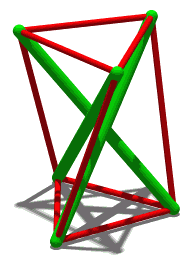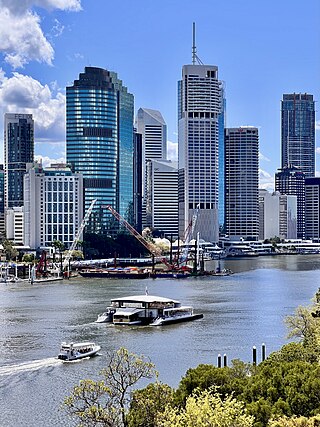
A suspension bridge is a type of bridge in which the deck is hung below suspension cables on vertical suspenders. The first modern examples of this type of bridge were built in the early 1800s. Simple suspension bridges, which lack vertical suspenders, have a long history in many mountainous parts of the world.

Tensegrity, tensional integrity or floating compression is a structural principle based on a system of isolated components under compression inside a network of continuous tension, and arranged in such a way that the compressed members do not touch each other while the prestressed tensioned members delineate the system spatially.

The Story Bridge is a heritage-listed steel cantilever bridge spanning the Brisbane River that carries vehicular, bicycle and pedestrian traffic between the northern and the southern suburbs of Brisbane, Queensland, Australia. It is the longest cantilever bridge in Australia.

The Goodwill Bridge is a pedestrian and cyclist bridge which spans the Brisbane River in Brisbane, Queensland, Australia. The bridge connects the South Bank Parklands in South Brisbane to Gardens Point in the Brisbane CBD.

The William Jolly Bridge is a heritage-listed road bridge over the Brisbane River between North Quay in the Brisbane central business district and Grey Street in South Brisbane, within City of Brisbane, Queensland, Australia. It was designed by Harding Frew and built from 1928 to 1932 by MR Hornibrook.

Albert Bridge is a heritage-listed railway bridge of steel truss design crossing the Brisbane River between Indooroopilly and Chelmer in the City of Brisbane, Queensland, Australia. It was designed by Henry Charles Stanley and built from 1894 to 1895 by John McCormick & Son as a replacement for an earlier bridge lost to flooding in 1893. Both bridges were named in honour of the Prince of Wales, Prince Albert. It was added to the Queensland Heritage Register on 21 October 1992.

Prestressed concrete is a form of concrete used in construction. It is substantially "prestressed" (compressed) during production, in a manner that strengthens it against tensile forces which will exist when in service.

Stonecutters Bridge is a high level cable-stayed bridge spanning the Rambler Channel in Hong Kong, connecting Nam Wan Kok, Tsing Yi to Stonecutters Island. The bridge deck was completed on 7 April 2009, and opened to traffic on 20 December that year. The bridge was the second-longest cable-stayed span in the world at the time of its completion.

Brisbane's recorded history dates from 1799, when Matthew Flinders explored Moreton Bay on an expedition from Port Jackson, although the region had long been occupied by the Yugara and Turrbal aboriginal tribes. The town was conceived initially as a penal colony for British convicts sent from Sydney. Its suitability for fishing, farming, timbering, and other occupations, however, caused it to be opened to free settlement in 1838. The town became a municipality in 1859 and a consolidated metropolitan area in 1924. Brisbane encountered major flooding disasters in 1893, 1974, 2011 and 2022. Significant numbers of US troops were stationed in Brisbane during World War II. The city hosted the 1982 Commonwealth Games, World Expo 88, and the 2014 G20 Brisbane summit

The Canton Tower, formally Guangzhou TV Astronomical and Sightseeing Tower, is a 604-meter (1,982 ft)-tall multipurpose observation tower in the Haizhu District of Guangzhou. The tower was topped out in 2009 and it became operational on 29 September 2010 for the 2010 Asian Games. The tower briefly held the title of tallest tower in the world, replacing the CN Tower, before being surpassed by the Tokyo Skytree. It was the tallest structure in China prior to the topping out of the Shanghai Tower on 3 August 2013, and is now the second-tallest tower and the fifth-tallest freestanding structure in the world.


The Denver Millennium Bridge is the world's first cable-stayed bridge using post-tensioned structural construction. Its 200-foot white tapered steel mast rises above Denver's northwestern skyline, connected to the bridge deck and foundation anchored by steel cables. The footbridge crosses railroad tracks and the regional light rail system, climbing no higher than 25 feet above street level, thereby minimizing the height pedestrians must climb.

The Hulme Arch Bridge in Hulme, Manchester, England, supports Stretford Road as it passes over Princess Road, and is located at grid reference SJ838968. The construction of the bridge formed part of the regeneration of the Hulme district of Manchester, both by re-establishing the former route of Stretford Road, which had been cut into two halves by the construction of Princess Road in 1969, and by providing a local landmark. The location was previously occupied by a footbridge.
SS John P. Gaines was a Liberty ship built during World War II by the Oregon Shipbuilding Corporation, and named for politician John P. Gaines. Northland Transportation Company was chartering the ship from the Maritime Commission and War Shipping Administration that owned the ship as part of the Merchant navy.

The Infinity Bridge is a public pedestrian and cycle footbridge across the River Tees in the borough of Stockton-on-Tees in northern England. The bridge is situated one kilometre downriver of Stockton town centre, between the Princess of Wales Bridge and the Tees Barrage. It connects the Teesdale Business Park and the University of Durham's Queen's Campus in Thornaby-on-Tees on the south bank of the Tees with the Tees Valley Regeneration's £320 million North Shore development on the north bank.

Santos Place is a 6 Star Green Star office building in Brisbane, Queensland, Australia. Construction began in 2007 and was completed in 2009. It was formerly known as Northbridge before major Australian oil and gas exploration production company Santos bought naming rights for the building in January 2009. Santos occupies eight levels.

Vidyasagar Setu, also known as the Second Hooghly Bridge, is a toll bridge over the Hooghly River in West Bengal, India, linking the cities of Kolkata and Howrah.

The Kangaroo Point Green Bridge is an under-construction pedestrian and cyclist bridge across the Brisbane River in Brisbane, Australia. The bridge will connect the suburb of Kangaroo Point with the Brisbane CBD.

The Neville Bonner Bridge is a footbridge spanning the Brisbane River in Brisbane, Australia, connecting the incomplete Queen's Wharf precinct in the Brisbane central business district to the South Bank Parklands in South Brisbane. The bridge is complete, but not yet open to the public, as it is part of the incomplete Queen's Wharf project, which is projected to open in April 2024. It is named after Neville Bonner, Australia’s first Indigenous member of the Parliament of Australia. The design concept for the bridge, by Grimshaw Architects, is an arch and single mast cable-stayed bridge with continuous shading supported by one mid-river pier. A large observation deck is located in the centre of the bridge.






























